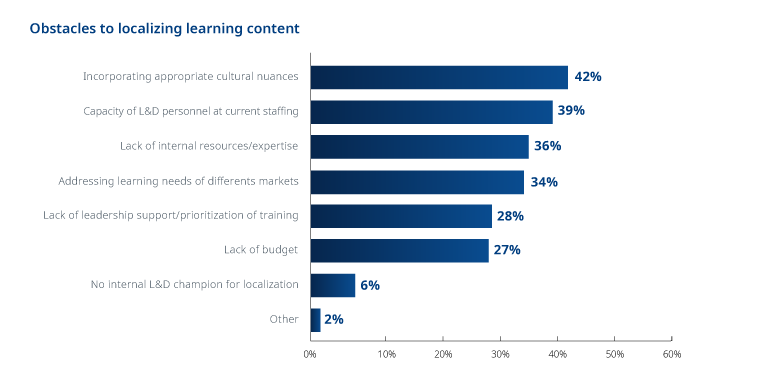Research reveals the challenges of localizing learning content
03 Sep 2024
 4 mins
4 mins

In partnership with Training Industry, we surveyed more than 300 learning and development (L&D) professionals about their localization strategies for L&D content. We discovered that enterprises definitely appreciate the value of adapting training content for different languages and cultures. The survey confirmed this in many ways, including with some interesting insights on where enterprise challenges lie in localizing learning content.
Importance of localization clearly demonstrated
The results clearly show that enterprises are serious about adapting training for different learner contexts. Asked what proportion of their organization's training content is translated or localized, they said (on average) that it's almost three-quarters – 73%, to be precise. Not only that, but half the respondents expected to localize even more training content in the next 12 months.
Then there's the fact that neither budget nor leadership support are among their top challenges when localizing learning content (see graph below). In fact, almost half of the respondents expected to have a larger localization budget for L&D in the next 12 months, and only 11% expected to have less to spend. Overall, these L&D professionals aren't struggling to justify and pay for the localization of training – which is presumably why they're already able to localize most of this content.

So what are their challenges in localizing learning content?
Instead of finding it challenging to justify and prioritize localization, enterprises are struggling more with how to integrate localization into their L&D strategies and ensure that they do in fact enhance learner engagement through localization. Their three biggest obstacles are incorporating appropriate cultural nuance (42%), the capacity to support localization at current staffing levels (39%), and a lack of in-house localization resource or expertise (36%).
Cultural nuance
Adapting learning content to reflect different cultural nuances gets to the heart of what localization is all about. Localization goes beyond 'mere' translation, requiring that it be more than just an accurate representation of bare meaning – it should also capture the intention and impact of the source content. This might, for example, require examples to be changed to resonate in a different cultural context, non-literal language to be thoughtfully reworked, or a different tone adopted to align with learner expectations.
And that's just the words. Training materials, especially for online learning, are often a mix of formats and fundamentally interactive. Localization requires the visuals (static or moving) to be adapted to different cultural realities, and sometimes the format or structure of the materials as well, to cater to different learning preferences. Failing to localize properly in all of these ways means that the content will resonate less with learners, who will therefore be less likely to engage with and understand it properly. All of which undermines the effectiveness of the training and the value it can deliver.
Among the challenges of localizing learning content, cultural adaptation – a much wider objective than translation – stands out. This challenge is so fundamental that I'm going to cover how to address it in two separate blogs to come – watch this space!
L&D capacity and localization resource/expertise
Faced with issues of L&D capacity or localization resource, enterprises are outsourcing some or all of their training localization work. Just over a quarter of the survey respondents manage localization entirely by outsourcing and more than half use some level of outsourcing.
Nevertheless, lack of capacity or resources remains a challenge for many. This is likely because it's not always easy to find the right partner to outsource to – one that knows how to address the unique localization demands of L&D content and can deliver real value for money. To learn more about what to look for in a training localization partner, read the survey report, Learning across borders: a survey of localization practices in corporate training and development.
Most of the enterprises surveyed are also using machine translation, either with or without human review and refinement. Besides its speed and cost benefits, it can also help to address resource issues, but the trick is knowing when it's suitable for use without human review, when it's suitable but only with human review, and when it isn't suitable at all. We'll explore this further in one of our later blogs addressing the issue of cultural nuance.
Learning across borders: the report
Our report is full of further insights from the survey and includes advice on how to start or improve your own localization efforts. You can find it here.
